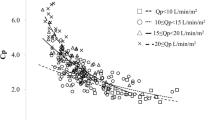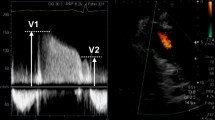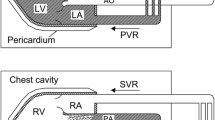Abstract
We assessed the usefulness of transthoracic Doppler-derived indexes obtained in the proximal pulmonary artery (PA) branch for estimating pulmonary vascular resistance (PVR) in 45 children with congenital heart disease (CHD) and 23 normal control subjects. The acceleration time, inflection time (InT), deceleration index, and peak velocity, which were measured from the systolic PA flow velocity curve obtained at the sites of the main PA, and right and left PA, were compared with the PVR in patients with CHD. In addition, changes in either Doppler-derived indexes or PVR during 100% oxygen administration were compared in 22 patients showing a baseline PVR ≥4.6 U/m2 (high PVR). The heart-rate-corrected InT (InTc) values obtained in the left PA in the high PVR group were significantly lower than those in the main PA (4.7 ± 1.5 vs. 7.5 ± 3.0; p < 0.001). The InTc obtained from the left PA separated patients with high and low PVR (4.7 ± 1.4 vs. 9.9 ± 2.4; p < 0.001) and no significant differences in InTc were found between the low PVR and the control groups. An increase in InTc to >6 during 100% oxygen administration for the high PVR group indicated good PA reactivity with a sensitivity of 93%, specificity of 100%, and agreement of 95% (κ = 0.83). Moreover, this InTc index correlated inversely with PVR (r = –0.80). In conclusion, our method can noninvasively separate high and low PVR and assess the PA reactivity for high PVR in children with CHD.





Similar content being viewed by others
References
Castelain V, Herve P, Lecarpentier Y et al (2001) Pulmonary artery pulse pressure and wave reflection in chronic pulmonary thromboembolism and primary pulmonary hypertension. J Am Coll Cardiol 37:1085–1092
Cooper MJ, Tyndall M, Silverman NH (1998) Evaluation of the responsiveness of elevated pulmonary vascular resistance in children by Doppler echo-cardiography. J Am Coll Cardiol 12:470–475
Dabestani A, Mahan G, Gardin JM et al (1987) Evaluation of pulmonary artery pressure and resistance by pulsed Doppler echocardiography. Am J Cardiol 59:662–668
Furuno Y, Nagamoto Y, Fujita M et al (1991) Reflection as a cause of mid-systolic deceleration of pulmonary flow wave in dogs with acute pulmonary hypertension: comparison of pulmonary artery constriction with pulmonary embolisation. Cardiovasc Res 25:118–124
Ha B, Lucas CL, Henry W et al (1994) Effects of chronically elevated pulmonary arterial pressure and flow on right ventricular afterload. Am J Physiol 267:H155–H165
Hanya S, Yoshimura H (1995) Analysis of development of mid systolic notch in pulmonary flow velocity waveform in patients with pulmonary hypertension. Kitasato Med 25:548–554
Hiraishi S, Horiguchi Y, Misawa H et al (1987) Noninvasive Doppler echocardiographic evaluation of shunt flow dynamics of the ductus arteriosus. Circulation 75:1146–1153
Hiraishi S, Misawa H, Hirota H et al (1994) Noninvasive quantitative evaluation of the morphology of the major pulmonary artery branches in cyanotic congenital heart disease. Circulation 89:1306–1316
Jarmakani JMM, Graham TP, Benson DR et al (1971) In vivo pressure-radius relationships of the pulmonary artery in children with congenital heart disease. Circulation 43:585–592
Kitabatake A, Inoue M, Asao M et al (1983) Noninvasive evaluation of pulmonary hypertension by a pulsed Doppler technique. Circulation 68:302–309
Kosturakis D, Goldberg SJ, Allen HD et al (1984) Doppler echocardiographic prediction of pulmonary arterial hypertension in congenital heart disease. Am J Cardiol 53:1110–1115
Milnor WR, Conti CR, Lewis KB et al (1969) Pulmonary arterial pulse wave velocoty and impedance in man. Circ Res 25:637–649
Nakayama Y, Nakanishi N, Hayashi T et al (2001) Pulmonary artery reflection for differentially diagnosing primary pulmonary hypertension and chronic pulmonary thromboembolism. J Am Coll Cardiol 38:214–218
Panidis IP, Ross J, Mintz GS (1986) Effect of sampling site on assessment of pulmonary artery blood flow by Doppler echocardiography. Am J Cardiol 58:1145–1147
Ritter SB, Cooper RS, Golinko RJ (1986) Noninvasive assessment of pulmonary hypertension and pulmonary vascular reactivity in congenital heart disease pulsed Doppler application. J Cardiovasc Ultrason 5:213–221
Serwer GA, Cougle AG, Eckerd JM et al (1986) Factors affecting use of the Doppler-determined time from flow onset to maximal pulmonary artery velocity for measurement of pulmonary artery pressure in children. Am J Cardiol 58:352–356
Shandas R, Weinberg C, Ivy DD et al (2001) Development of a noninvasive ultrasound color M-mode means of estimating pulmonary vascular resistance in pediatric pulmonary hypertension. Mathematical analysis, in vitro validation, and preliminary clinical studies. Circulation 104:908–913
Tahara M, Tanaka H, Nakao S et al (1981) Hemodynamic determinants of pulmonary valve motion during systole in experimental pulmonary hypertension. Circulation 64:1249–1255
Tomita H, Nakaya S, Futaki S et al (1985) Noninvasive evaluation of the pulmonary vascular resistance by pulsed Doppler echocardiography. In: Doyle EF (ed) Pediatric cardiology; Proceedings of the Second World Congress. Springer-Verlag, New York, pp 91–94
Van den Bos GC, Westerhof N, Randall OS (1982) Pulse wave reflection: can it explain the differences between systemic and pulmonary pressure and flow? Circ Res 51:479–485
Van Dijic APJ, Hopman JCW, Klessens JHGM et al (1996) Is noninvasive determination of pulmonary artery pressure feasible using deceleration phase Doppler flow velocity characteristics in mechanically ventilated children with congenital heart disease. Am J Cardiol 78:1394–1399
Acknowledgments
We gratefully acknowledge the technical assistance of Mr. Yoshiyuki Makita, Mrs. Keiko Fukuoka, and Miss Nobue Imaki.
Author information
Authors and Affiliations
Corresponding author
Rights and permissions
About this article
Cite this article
Nakahata, Y., Hiraishi, S., Oowada, N. et al. Quantitative Assessment of Pulmonary Vascular Resistance and Reactivity in Children with Pulmonary Hypertension Due to Congenital Heart Disease Using a Noninvasive Method: New Doppler-Derived Indexes. Pediatr Cardiol 30, 232–239 (2009). https://doi.org/10.1007/s00246-008-9316-y
Received:
Revised:
Accepted:
Published:
Issue Date:
DOI: https://doi.org/10.1007/s00246-008-9316-y




